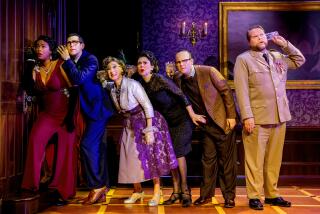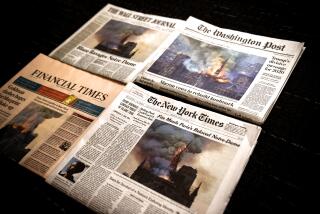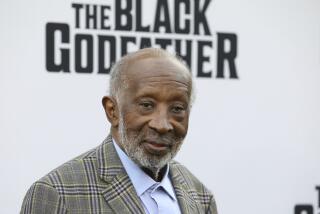Clash of the Titans : HENRY AND CLARE: An Intimate Portrait of the Luces, <i> By Ralph G. Martin (G. P. Putnam’s Sons: $24.95; 464 pp.)</i>
- Share via
They were America’s original media couple, a twosome whose combined accomplishments make those of such latter-day husband-and-wife teams as Ben Bradlee and Sally Quinn or Harold Evans and Tina Brown appear paltry. The man of the house, Henry Luce, founded Time, Fortune, Sports Illustrated and Life. Meanwhile his consort, Clare Boothe, edited Vanity Fair, wrote the campy stage classic “The Women,” served two terms as a U.S. congresswoman and one term as America’s ambassador to Italy and until her death in 1987, reigned as the grande dame of the Grand Old Party.
But as we learn in “Henry and Clare”--Ralph G. Martin’s sloppily sourced, too glibly written, but still luridly engaging dual biography--no two people could have been more poorly suited for a happy life together.
The son of Presbyterian missionaries to China, Luce exemplified both the good and the bad of what he characteristically called “the American century.” Humble, earnest, pious--each morning, as he ascended in a private elevator to his office atop the Time-Life Building, he knelt in prayer--and, above all else, inquisitive, he essentially created the news magazine as we today know it. With an $86,000 loan and stories lifted from newspapers then recast in a breezy, opinionated style, Luce and Yale classmate Briton Hadden Jr. brought out Time’s premier issue in 1923. Though Hadden--who died prematurely in 1929--was the wordsmith of the two, coining such neologisms as smog (a merging of smoke and fog) and socialite (a merging of social and light), it was Luce who infused the enterprise with a sense of purpose. “We went in every week to remake the world,” said one early staffer.
By 1936, when he gave birth to Life, Luce was a millionaire and, not incidentally, the most powerful publisher in the land. As with many press barons, Luce sometimes abused that power, but unlike a William Randolph Hearst--who twisted facts to sell papers--Luce distorted the truth to sell conservative ideologies. During the 1940s, Luce’s bias against Mao Tse-tung was so overt that writer Teddy White posted a sign in the publications’ China bureau that read: “Any relationship between this correspondent’s dispatches and what appears in Time magazine is purely coincidental.” And during the 1952 presidential campaign, the publisher pulled out all the stops for Dwight D. Eisenhower, even going so far as to send one issue of Time to the printer a day early so that copies containing pieces puffing Ike could be on the floor of the Republican convention in time to sway undecided delegates. In defense of this policy, Luce informed his editors: “Eisenhower is right for the country . . . therefore any form of objectivity is unfair.”
Save for a corresponding lust for power and ardor for right-wing causes, Clare Boothe was utterly unlike her husband. Abandoned by her father at a tender age and reared by her covetous, stage-struck mother--Anna Boothe was the quintessential vamp, a member of the chorus line who viewed gold-digging as a valid occupation--young Clare grew up too fast. Self-contained, cynical, cold, she might well have become one of those anonymous, heartless flappers of the sort Scott Fitzgerald made famous. Yet thanks to an interlude at a Catholic girl’s school where she acquired a love of reading, Clare polished off her rough edges. And thanks to her mother’s overarching ambitions, she kept her eyes open for the main chance.
In 1923, the same year Luce was unveiling Time, Clare spotted her mark. George Brokaw--wealthy, handsome and bad to go to the bottle--was the scion of a socially impeccable New York family. Clare’s six-year-marriage to this fashionable Knickerbocker left her with a daughter, a Manhattan home, a substantial annual income, and a trove of stories about the beau monde. In 1929, writing under the name Julian Jerome, Clare began selling these stories to Vanity Fair. Soon thereafter--thanks to her talent, gall and the fact that she was, in the words of photographer Cecil Beaton, “drenchingly beautiful”--she parlayed this break into an editorial position with Conde Nast. By 1932, she was Vanity Fair’s managing editor, rejecting articles by Sinclair Lewis, corresponding with George Gershwin, and--if our author is to be believed--indulging in an endless spree of steamy dalliances with men as gifted as John O’Hara, as eccentric as Buckminister Fuller, and as rich as Bernard Baruch. No man could resist her, observed a friend, and this was certainly true of Henry Luce, who in 1934 after just two meetings with Clare abandoned his wife of 11 years and proposed matrimony.
In short, what we have here are the makings of an epic match, the mating of a pillar of rectitude with the most vivacious and voracious mantrap since Venus. And that it all played out against the proverbial backdrop of history and in a milieu peopled by a cast from the front pages simply makes it more intoxicating. Yet Ralph Martin, who is no stranger to these stomping grounds (his prior efforts include “The Woman He Loved: The Story of the Duke and Duchess of Windsor”), has melded this material into a gaudy, gimcrack of a book that repels even as it titillates.
The chief problem with “Henry and Clare”--much of which focuses on its protagonists’ adulteries--is not that it offends propriety. By most accounts, the Luces were brazenly unfaithful to one another. Clare’s Achilles heel was men in uniform, among them Gen. Lucian K. Truscott, while Henry’s was brainy nursemaids, among them Lady Jean Campbell, who’d give him the one thing his wife wouldn’t: understanding. Moreover, both Luces lived by the sword journalistically, so it’s hypocritical to make the case that they deserve posthumous privacy. No, what rankles is that Martin advances far too much of his sensationalistic tale through either quotations from unnamed sources or innuendo.
While few readers want to stumble through a thicket of footnotes, most appreciate knowing that a work is grounded in facts. Though Martin seems to have done a great deal of research--his end notes are brimming with titles of books read, names or archives visited, and dates of interviews--he rarely uses this material to back up his scandalous assertions with concrete citations. For instance, anyone interested in finding out how Martin learned about Clare’s alleged affair with “the handsome celebrated” CBS TV reporter Eric Sevareid will discover that the author can only say: “Chapter 25 sources apply here, too. Add Mary Bancroft interview Columbia Oral History.”
While Martin’s refusal to support allegations with specific notations may spring from something as unattractive but relatively benign as shoddiness, his penchant for tarring his subjects with the broad brush of gossipy rumor feels far more malignant. Indeed, when ruminating on the possibility that Clare’s refusal to work for Richard Nixon in the 1960 presidential campaign may have resulted from a sexual encounter she purportedly had with John Kennedy, Martin resorts to the now infamous Kitty Kelley gambit of placing two people in a room and implying everything by proving nothing. It’s one thing to report that Clare and J.F.K. had “a long private visit,” but it’s another then to inquire: “Was she attractive enough to intrigue John Kennedy?”
Yet for all his sins, Martin has written a book that’s hard to put down. In part, this is because the Luces lived in fascinating times, and due to the clout of his magazines and her political connections, they did know everyone who was anyone. Herein, we get vivid sketches of such luminaries as Franklin D. Roosevelt, who despised Clare, ordering an aide to “get that damn woman out of my office.” We also--thanks to Martin’s use of the acid reminiscences of several Time Inc. alums--get a thorough portrait of the various internecine squabbles that shaped the publishing firm. Most important, Martin has done enough digging to paint what feels like a true-to-life picture of a pathological marriage, a pairing that at one point prompted Luce to make the sad boast: “I’ve been married to her now for fourteen years . . . of sheer hell. But by God I’ve fought her to a standstill.”
Nevertheless, any two lives--and particularly these two lives--add up to more than a collection of tawdry snapshots. Both Henry and Clare merited better than “Henry and Clare.”
More to Read
Sign up for our Book Club newsletter
Get the latest news, events and more from the Los Angeles Times Book Club, and help us get L.A. reading and talking.
You may occasionally receive promotional content from the Los Angeles Times.










